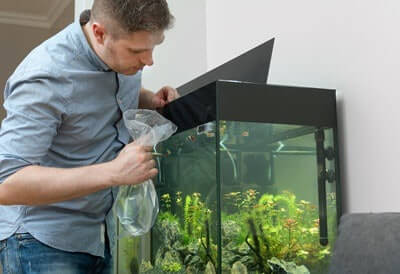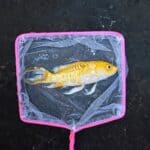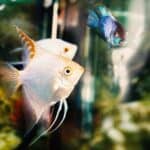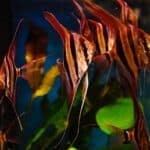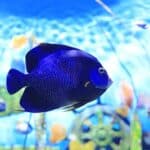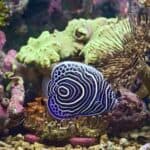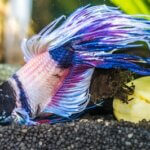Last Updated on: 1st November 2023, 02:33 pm
All fish tanks experience algae growth as it’s a natural part of the aquarium ecosystem.
Wherever there’s light and water, there is algae. While they have some benefits, too much is a problem, so you must keep it under control.
To control algae, ensure there’s not too much light or excess nutrients in your tank. Warm temperatures also encourage them to grow, so you’ll need to monitor your tropical fish tank for signs of growth.
When algae grow, you must remove it. You can do this by manually scraping them off or getting a multi-stage filter, which is more effective than standard filters.
Carry out frequent water changes and consider getting a UV sterilizer to kill algae and other microorganisms.
Removing algae isn’t hard, but it must be done to keep conditions healthy for your plants and fish.
Is Algae Good or Bad in a Fish Tank?
Algae has several uses in an aquarium – many benefit the tank’s ecosystem. Like plants, algae use photosynthesis to convert light and organic nutrients in the water into new algae.
However, unlike plants, they can survive in worse conditions as they’re a more simplistic lifeform. They can absorb more wavelengths of light and consume compounds that plants can’t use.
Too much algae can be a problem and signify that your tank has a chemical imbalance or too many pollutants, such as ammonia and nitrites. As described by Science Daily, an algae bloom (or algal bloom) is a rapid increase in the algae population.
They occur when the tank is exposed to too much light or carbon dioxide and too many nutrients. It can make the water go cloudy and the fish sick. However, algae aren’t all bad and have the following benefits:
Minimizes Toxins
Along with other microorganisms, including bacteria, algae help minimize toxic nitrogen in the water.
Algae also use ammonia as a food source, keeping this harmful toxin under control. Ammonia is a significant problem in fish tanks.
Too much poisons fish and causes:
- Red or cloudy eyes.
- Lethargy.
- Redness around the gills.
- Appetite loss.
- Breathing difficulties.
The right amount of algae keeps ammonia and nitrites at bay, preventing them from becoming a problem within the tank.
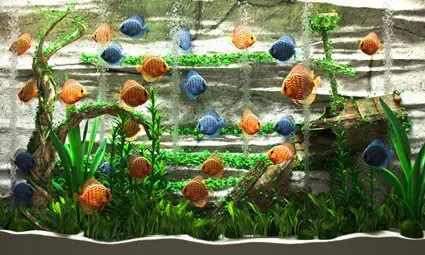
Produce Oxygen
Algae produce oxygen during the day as a by-product of photosynthesis.
They consume oxygen at night, but it’s far less than they make, leaving enough for the fish in the tank. Algae also reduce carbon dioxide by consuming it, keeping the tank’s conditions safe for fish.
Food for Fish
Algae benefit tanks because fish and other invertebrates nibble on them. In turn, this keeps the tank clean. Several fish eat algae, eliminating the excess and reducing the chances of an algae bloom.
According to Plant Signaling and Behavior, algae produce compounds called metabolites. They’re the basis of the marine food chain, providing fish with the essential nutrients they need to survive.
How Does Algae Grow in a Fish Tank?
Algae thrive when water conditions are unbalanced.
Unfortunately, balancing the temperature, nutrients, and lighting is tricky, so algae are common in almost all fish tanks. If they can get a footing, they’ll rapidly multiply, becoming a problem.
The following things are what causes algae to grow:
Excessive Lighting
Light is algae’s primary energy source. Without it, algae can’t grow or bloom. However, all fish tanks need light to provide fish with oxygen and vitamin D to help plants grow.
A little sunlight won’t cause the algae to grow too much, but leaving the lights switched on or placing your tank in direct light causes problems.
Too Many Nutrients
Algae consume decaying debris, fish and food waste, and toxic waste. Unclean tanks that contain these things provide algae with what they need to grow.
One of the most common food sources for algae is fish food left in the tank.
It decays, providing algae with the nutrients they need to grow. That’s why you should remove any uneaten food a few minutes after you’ve put it into the tank.
If your fish don’t eat it within five minutes, they won’t return to it later and won’t benefit from it remaining in the tank.
Warm Water
Algae flourish in warm temperatures. They’re common in tropical fish tanks and tanks that use heaters.
Cooling the tank isn’t possible, as it’ll affect your fish, so frequently removing it is the only way to effectively keep it under control without stressing or upsetting your fish.
What Are the Different Types of Algae?
There are several different types of algae, but the kinds most commonly found in fish tanks are:
Black Algae
Black algae, also known as black beard algae, is a red algae that thrives in high-phosphate environments.
They more commonly appear in saltwater tanks and are signs that your aquarium needs a water change or the tap contains too much phosphate.
Black beard algae are safe for fish. Most are happy to swim amongst it. However, if left unattended, they grow into a thick, bushy jungle and cover all aquarium surfaces.
White Algae
White algae in a fish tank looks like a web or film that quickly spreads.
They look foul and become a nuisance for your fish. White algae most commonly grow on driftwood, ornaments, and rocks but rarely on the tank.
White algae are caused by the same things as all other algae, so improving the tank’s conditions should keep them at bay. While white algae aren’t toxic for fish, you don’t want them to take over the tank.
Diatoms
Diatoms aren’t algae but a tiny animal called a diatom. They’re problematic for saltwater tanks, as they form slimy, gold-brown coatings on the glass and objects in the tank.
Diatoms in your aquarium can turn your tank water cloudy during an algae bloom. They thrive in aquariums with poor water quality and low light.
Green Algae
Green algae are most commonly found in freshwater tanks. They contain chloroplasts and undergo photosynthesis, making food and producing oxygen.
The types of green algae include:
- Sea lettuce.
- Horsehair algae.
- Dead man’s fingers.
Blue-Green Algae
Blue-green algae aren’t so much an alga as bacteria. They grow on plants and decorations, creating a film and a foul-smelling odor. You’ll also find them in the substrate and the tank’s glass.
Brown Algae
Brown algae are some of the largest algae species. They consist of seaweed varieties and kelp in marine environments. They’re not very common in fish tanks.
How To Remove Algae from a Fish Tank
As we’ve already mentioned, removing algae isn’t tricky, but it should be something you add to your tank cleaning routine. You’ll never eradicate them.
That said, you can keep algae under control in the following ways:
Multi-Stage Filter
A multi-stage filter can help you remove large amounts of algae.
While standard aquarium filters effectively remove chemical, biological, and mechanical waste, most struggle to keep up with algae growth, allowing them to accumulate. Choosing a more powerful filter that removes algae before they can multiply will improve the environment for your fish.
The only thing to remember with a multi-stage filter is that it won’t remove algae that covers glass, decorative features, and plants, so you’ll need to tackle that separately.
Manual Scraping
Even though manual scraping takes time and effort, it is an effective algae remover. You can do it alongside a multi-stage filter to ensure all the excess algae is removed.
You can find decent aquarium algae scrapers online and in aquarium stores, so they’re easy to get hold of. Don’t use a razor blade to do this, or you’ll scratch the tank and ruin it.
Before cleaning, move your fish into a temporary replacement tank and wear thick gloves so your skin doesn’t come into contact with the water.
Scrape the glass, ornaments, substrate, and rocks until you remove all the algae. Then, rinse everything.
If you’re wondering how to clean algae from fish tank ornaments, you can use an algae scraper.
UV Sterilizers
A UV sterilizer is a machine that emits UV light to kill microorganisms and is one of the most efficient and effective ways to remove algae.
They don’t just kill algae, but they destroy harmful bacteria and other pathogens, contributing to an unhealthy environment.
The only downside is that they can be expensive, but they’re worth the money.
Water Changes
Partial water changes should be an essential part of your cleaning regimen. They stop toxins from building up in the tank, preventing your fish and plants from dying prematurely.
Not only do water changes remove toxins, but they also eliminate algae. For example, removing 50% of the water removes 50% of the accumulated algae.
While it’s tempting to replace 100% of the water in one go, doing so removes the beneficial bacteria that have developed, making conditions dangerous. Instead, swap out:
- Once a month, if you have a powerful filter or very few fish.
- Once every two weeks, changing about 30% at a time.
- Once a week, changing 15-20% at a time.
- Twice a week, changing 5-10% at a time.
Algaecides
If you’re dealing with a significant or stubborn algae bloom, you might need to use an algaecide, which is a chemical that works as an algae killer and prevents future growth by destroying or suffocating them.
Only use algaecides in extreme circumstances when all other methods have failed. They could have a long-term effect on your fish and plants, so only use them twice yearly to prevent problems.
How To Avoid Algae in a Fish Tank
There are several things you can do to minimize the chances of algae growth naturally, including:
Reduce the Light
High-output lighting that’s on for long periods of the day causes algae to proliferate.
To slow the algae’s growth, reduce the lighting used for your tank or lower the intensity until the algae dissipates. If you can’t do this, turn it off for a few more hours than usual every day.
To avoid algae altogether, make sure you don’t have your lighting on too bright or too often in the day. Eight hours a day is usually enough for plants and fish.
This might take trial and error to get right – and don’t forget your fish need light to survive.
Control Nutrients
We’ve mentioned how algae consume excess nutrients, so try to control what’s in your tank. To do this:
- Don’t leave rotting food in the tank.
- Remove dead fish as soon as you see them.
- Change the water regularly to keep the nutrients low.
Another thing worth doing is testing the water to ensure it’s not experiencing spikes in ammonia in nitrites. Doing this allows you to act quickly, preventing algae from making their move and bedding in.
Add Plants
Planting healthy, fast-growing aquatic plants is a good idea, as they can fight off algae naturally, preventing you from needing to step in to clean the tank too often.
Use liquid fertilizer to strengthen them and use a fixed photoperiod of eight hours. This creates a natural, healthy ecosystem that stops algae from becoming problematic.
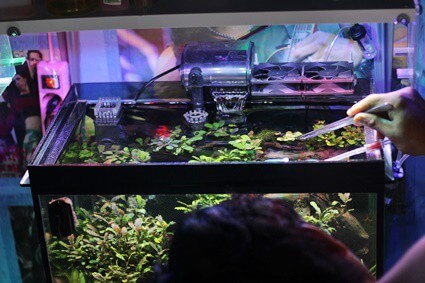
What Are Some Algae-Eating Fish?
Another way to naturally remove algae is to add algae-eating fish into your tank.
Their primary purpose is to consume excess algae, keeping them at bay. Most are compatible with other fish, so research and choose which one fits into your aquarium the best.
American Flagfish
American flagfish hail from Florida and are known to eat hair algae.
They’re hardy and temperate, meaning they suit most aquariums. They are prone to nipping at other fish’s fins, so make sure there are enough weeds for them to clean algae off to keep them occupied.
Black Mollies
Black Mollies are easy to find in the aquarium trade and make an excellent addition to most tropical tanks. Poecilia sphenops are the best and do a brilliant job cleaning up excess algae.
Bristlenose
Bristlenose fish are one of the best algae-eaters for your fish tank.
They don’t get too big and reach around 12.5 cm in length. They’re also hardy and easy to care for, making them a unique, interesting, and efficient addition to your fish tank. They’re also beautiful to look at.
Garra Rufa
Also called “drab,” Garra rufa fish aren’t picky about what they eat.
They suck algae off rocks and stick to the bottom of the tank in search of something to eat. Despite being known as ugly fish, they’re fascinating and make an exciting addition to any fish tank.
Algae-Eating Shrimp
Algae-eating by name, algae-eating by nature. These shrimp effectively eliminate all alga types and love eating them off plants and decorative features.
Other excellent algae-eating shrimp include the japonica and amano breeds. Just be mindful about what fish you keep them with, as some will eat the shrimp.
Flying Fox
Flying fox fish are universally used for algae control – specifically, hair and brush algae.
They grow to 15 cm long, so they’re better suited to larger aquariums with room to move. They have a peaceful nature but are always ravenous, so they eat leftover detritus.
Otocinclus
Otocinclus are nano-sized catfish from South America. They’re perfect for small fish tanks with little fish.
They’re well-behaved and spend most of their day looking for algae to graze on. They’ll eat Amazon sword plants, though, which is something to bear in mind if you have some.
African Cichlids
African cichlids are used to constantly eating algae and are happy to spend their days grazing on whatever they can find in the tank.
Malawi mbuna is an excellent choice, but members of the Labeotropheus family are the best if you want quick, fast results.
Chaetostoma
Also known as bulldog plecs, chaetostoma are found at altitude in South African streams and enjoy the fast-flowing, cool water. They’re tiny dwarf fish that effectively eat algae and look great.
Algae is expected in all fish tanks, so don’t worry if you discover some.
The problem lies when you allow them to proliferate and take over the tank. Not only does it look unsightly, but your fish will suffer.
That’s why you must do everything you can to prevent it from growing in the first place.

